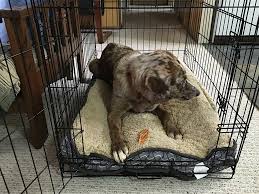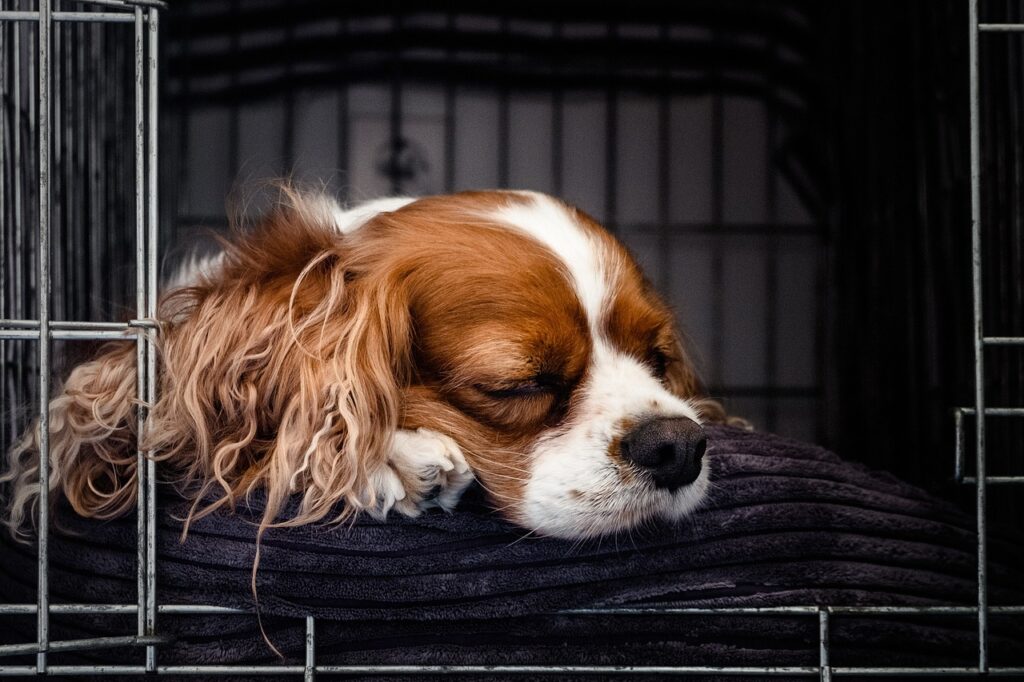Crate training is a popular method of house-training puppies, and for good reason. It is a method of housebreaking your puppy by teaching them to associate their crate with a safe and secure place.
A crate is a small, enclosed space that serves as a puppy’s den.
Crate training is not the same as confinement, nor should it be used as a punishment.
A crate should be a positive and comforting space for your puppy, where they can relax and feel secure.
Table of Contents
Why is Crate Training Important?
Crate training has numerous benefits for both you and your puppy. Here are just a few:
- It helps with housebreaking: Dogs instinctively avoid soiling their den, so crate training can be an effective way to teach your puppy to hold their bladder and bowels.
- It keeps your puppy safe: When you’re not able to supervise your puppy, such as when you’re at work or sleeping, a crate can keep them out of harm’s way.
- It prevents destructive behavior: Puppies may chew on furniture or other items when they’re unsupervised, but a crate can keep them from causing damage.
- It provides a safe and secure space: Just like humans, dogs need a space they can retreat to when they feel anxious or overwhelmed. A crate can provide that sense of security for your puppy.
Preparing for Crate Training
The first step in crate training is choosing the right crate. You should consider factors such as, size, material, and style.
- Size: You’ll want to make sure your puppy can stand up, turn around, and lie down comfortably. However, it shouldn’t be too big, or your puppy may use one end as a bathroom and the other end as a sleeping area. As your puppy grows, you may need to upgrade to a larger crate.
- Material: Crates are typically made from wire, plastic, or fabric. Each material has its own advantages and disadvantages.
- Wire crates are durable and easy to clean, but they can be noisy and may not be suitable for puppies who are anxious or nervous.
- Plastic crates are sturdy and provide more privacy, but they can be heavy and difficult to store.
- Fabric crates are lightweight and portable, but they may not be suitable for puppies who like to chew or scratch.
- Style: There are several styles of crates to choose from, including traditional wire crates, airline-approved crates, and soft-sided crates. Consider your lifestyle and your puppy’s needs when choosing a style.
Introducing the Crate
Introducing your puppy to the crate is an important step in the crate training process.

Start by placing the crate in a quiet, low-traffic area of your home and leaving the door open. Encourage your puppy to explore the crate by placing treats and toys inside. Once your puppy is comfortable entering and exiting the crate, start closing the door for short periods of time while you are home.
To make the crate a comfortable and safe space for your puppy, add a soft blanket or bed and a few toys. Avoid placing food or water inside the crate, as this can lead to accidents.
When your puppy voluntarily goes into the crate, reward them with a treat or verbal praise. This will help them associate the crate with positive experiences.
Getting Started with Crate Training
Creating a crate training schedule is important for establishing a routine and helping your puppy adjust to spending time in the crate. You should always start with short periods of time. When you first start crate training, only leave your puppy in the crate for short periods of time. This will help them get used to being in the crate without feeling overwhelmed or anxious.
Use positive reinforcement techniques, such as treats and praise, to encourage your puppy to enter the crate voluntarily.
Avoid using punishment-based training methods, such as yelling or hitting, as this can cause fear and anxiety in your puppy and make crate training more difficult.
Crate Training Techniques
- Gradual introduction to the crate is key to successful crate training. Starting with short periods of time while you are home and gradually increasing the length of time they spend in the crate will lead to successful crate training.
- Encourage your puppy to enter the crate voluntarily by placing treats and toys inside.
- Lengthening the time spent in the crate is an important step in crate training, you will want to gradually increase the length of time.
- Make sure to provide plenty of exercise, playtime, and bathroom breaks before and after crate time to ensure that your puppy is comfortable and content.
- Encouraging your puppy to enter the crate voluntarily is another important aspect of crate training. Use positive reinforcement techniques, such as treats and praise, to encourage your puppy to enter the crate on their own.
- Avoid forcing your puppy into the crate or using punishment-based training methods, as this can cause fear and anxiety.
- Preventing destructive behavior in the crate is also important for successful crate training. Provide your puppy with plenty of toys and chew items to keep them occupied and prevent boredom. If they are left to long they can become frustrated and produces a destructive behavior.
Common Crate Training Problems and Solutions
- Whining and barking in the crate is a common problem during crate training. To address this, avoid responding to your puppy’s cries or barks, as this can reinforce the behavior. Instead, wait for a moment of quiet before letting your puppy out of the crate.
- Refusal to enter the crate can also be a problem during crate training. To address this, try placing treats and toys inside the crate to encourage your puppy to enter. You can also feed your puppy their meals inside the crate to associate it with positive experiences.
- Accidents in the crate can be frustrating, but they are a common occurrence during crate training. To address this, make sure that your puppy has plenty of opportunities to go outside and use the bathroom before and after crate time.
- Avoid leaving food or water inside the crate, as this can lead to accidents.
- Escaping the crate can be dangerous for your puppy and can also lead to destructive behavior. To address this, make sure that the crate is properly secured and that your puppy cannot push or chew their way out.
- You can also try placing a blanket or towel over the crate to create a more den-like environment and reduce the urge to escape.
Tips for Successful Crate Training
Here are some additional tips for successful crate training:
- Never use the crate as a punishment: Using the crate as punishment will become a place your puppy never wants to go.
- Too long? leaving your puppy in the crate for too long can lead to anxiety and stress. Puppies also have small bladders, so be mindful of that. Hiring a pet sitter or dog walker to let your puppy out may be an option.
- Use positive reinforcement: Encourage your puppy with positive reinforcement such as treats and verbal praise, to encourage good behavior.
- Be patient: You can easily get discouraged if your puppy doesn’t take to the crate right away, but you have to remember, crate training takes time and patience. With consistency and positive reinforcement, they will eventually learn to love their crate.
- Never force your puppy into the crate: Forcing your puppy into the crate can create negative associations and make crate training more difficult. Instead, encourage them with treats and praise.
- Use the crate as a safe space: The crate should be a safe and comfortable space for your puppy. Again, never use it as a form of punishment or isolation.
- Consider crate location: Where you place the crate can impact your puppy’s comfort level. Always select a place that is quiet, comfortable, and away from high traffic areas.
Frequently Asked Questions
Is crate training cruel?
No, crate training is not cruel when done properly. A crate can provide a safe and comfortable space for your puppy, and can also help prevent destructive behavior and separation anxiety.
Can I crate train an adult dog?
Yes, it is possible to crate train an adult dog. However, it may take longer than crate training a puppy, as adult dogs may have established habits and behaviors that need to be addressed.
Can I use a soft-sided crate for crate training?
Yes, you can use a soft-sided crate for crate training.
However, it is important that the crate is well built and there is plenty of ventilation, and that your puppy cannot chew their way out.
How do I know if my puppy is ready to be left alone in the crate?
The key is to take things slow and steady.
Start by leaving your pup in the crate for short periods of time and then gradually increase the duration.
Keep an eye on your puppy’s behavior – if they seem comfortable and content in the crate, and aren’t causing any trouble like chewing or barking excessively, then they might be ready for longer stretches in the crate.
Conclusion
Crate training can be a valuable tool for house training puppies and preventing destructive behavior and separation anxiety.
By choosing the right crate, gradually introducing your puppy to the crate, and using positive reinforcement techniques, you can successfully crate train your puppy.
And by addressing common problems and concerns, you can ensure that your puppy is comfortable and content in their crate. There are more ways to train your puppy, take a look at our article on types of dog training.


Dennis and Becca, have always shared a passion for man’s best friend. As dog enthusiasts, they put together articles that inform, engage, and captivate fellow dog lovers.